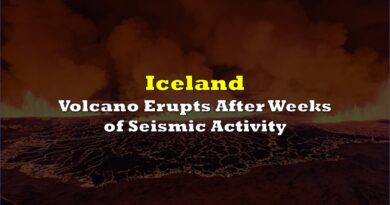Volcanic Eruption Resumes on Iceland’s Reykjanes Peninsula, Lava Flows Enter Town and Swallows Entire Houses
After a four-week lull, a volcano on Iceland’s Reykjanes Peninsula has roared back to life, triggering a series of earthquakes and opening new fissures near the town of Grindavík, according to the Icelandic Met Office (IMO) on Sunday.
Like the earlier eruption, this one was preceded by a series of earthquakes that began around 3 a.m. in the Sundhnúksgígar area and then toward Grindavík. At 8 a.m., a new fissure opened at the southeast of the Hagafell mountain, spewing lava. At around noon, another lava-spewing fissure opened, this time just north of Grindavík, spreading lava into town where it engulfed entire homes.
IMO’s analysis of seismicity and ground deformation data suggests that a magma dike beneath the Reykjanes Peninsula has reached Grindavík, potentially reactivating existing faults and fractures, and creating new fissures. Experts also warn that additional fissures may open in the days ahead as magma continues to feed the dike.
Þorvaldur Þórðarson, a volcanology and petrology professor at the Icelandic University, notes a shift in eruptive activity towards Grindavík, presenting two ominous scenarios. The first scenario entails the continuation of activity in the lower fissure, causing lava to flow towards the town. The second, more concerning scenario, involves an escalation in the upper fissure’s eruption.
“It seems to me that the fissure is always getting longer,” Þórðarson said. “The situation has unfortunately become very bleak for Grindavík.”
Patrick Allard, a volcanologist from France’s Institut de Physique du Globe de Paris told AFP that the eruption confirms that a long-dormant faultline, which he also described as fragile, has woken up. The eruption on Sunday is the fifth in the Reykjanes peninsula since March 2021. Before these eruptions, the area had not seen one in centuries.
“After eight centuries of a relative break and a complete cessation of surface activity, we have entered a new episode of plate separation which could last several years – possibly decades,” Allard said. He added that Grindavík was built on lava flows from the last eruptions 800 years ago.
The location of the faultline also endangers the Svartsengi geothermal plant, the source of both electricity and water to 30,000 people living in the Reykjanes peninsula, a tenth of the country’s population.
Information for this story was found via LiveScience, AFP via Science Alert, and the sources and companies mentioned. The author has no securities or affiliations related to the organizations discussed. Not a recommendation to buy or sell. Always do additional research and consult a professional before purchasing a security. The author holds no licenses.


